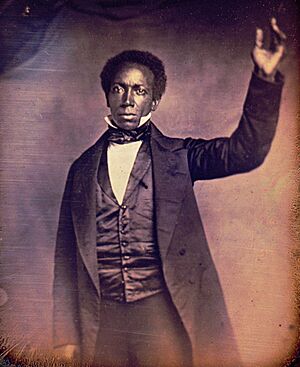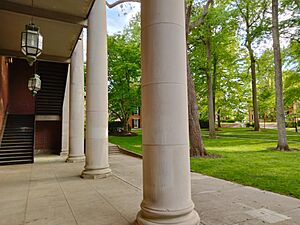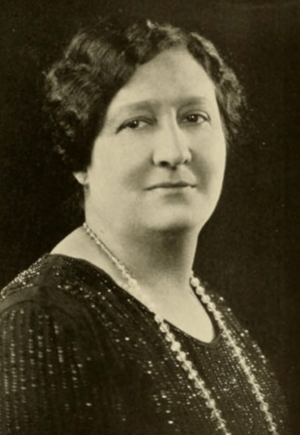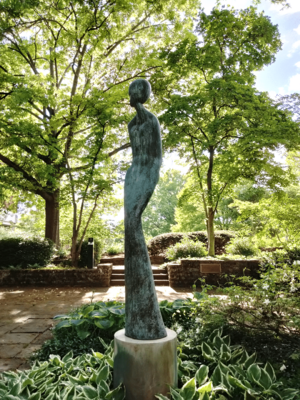History of Ohio University facts for kids
The history of Ohio University began even before the university was officially started. It's part of the story of America after the American Revolution, when the first land was set aside for public use. The university's journey has included times of struggle, big changes, and becoming a leader in research and modern education. Much of this story comes from the book Ohio University 1804–2004: Spirit of a Singular Place by Betty Hollow.
Contents
How Ohio University Began
Early Ideas and Laws
People in the United States had supported public education for a long time. Manasseh Cutler, a chaplain from the American Revolutionary War, had the idea for Ohio University. He is known as the school's founder, along with General Rufus Putnam.
On March 1, 1786, Cutler met with Putnam and others to form the Ohio Company of Associates. This group of former Revolutionary War soldiers wanted to buy a lot of land (about 1.5 million acres) near the Muskingum River. Their plan included setting aside two special areas, called "College Lands," for a university. These lands are in the Appalachia region.
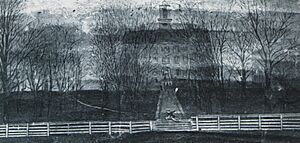
The Congress of the Confederation approved this plan. This led to the Northwest Ordinance of 1787, a very important law. It specifically supported higher education by giving land for a university. This made Ohio University the first public university ever created by an act of Congress. It was founded with the goal of spreading education.

The Northwest Ordinance was a groundbreaking law. It set a rule that the U.S. government would grow westward by adding new states, not just by expanding existing ones. Thomas Jefferson influenced how the land would be divided into townships for orderly settlement.
The ordinance also banned slavery in the territory. This rule, written by Cutler, made the Ohio River a border between areas where slavery was allowed and where it was not. This decision later played a role in disagreements leading up to the American Civil War.
The 1787 ordinance strongly encouraged public schools. It stated that "Religion, morality and knowledge being necessary to good government and the happiness of mankind, schools and the means of education shall forever be encouraged." This important phrase is even carved on the university's gateway.
Ohio became a free state because of this ban on slavery. Ohio University became the first "land grant" institution in the U.S. This means it was given land by the government to help it start and grow. This happened much earlier than other famous land grant colleges.
Building the University
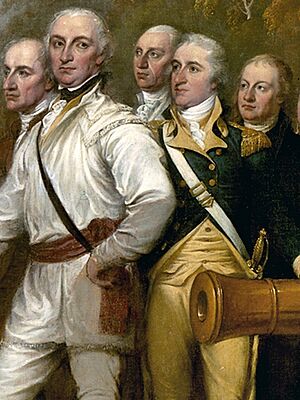
By 1788, Rufus Putnam and his team had surveyed and planned a town for the future university. In 1797, settlers from Marietta, Ohio traveled to find a spot for the school. They chose Athens because it was located between the original capital of Chillicothe, Ohio and Marietta.
On February 18, 1804, a third charter was approved, officially creating "Ohio University." This happened about a year after Ohio became a state. On December 6, 1804, the first trustees, including Putnam and Governor Edward Tiffin, met to raise money for the university by leasing its lands.
In 1806, a two-story building was finished on the College Green. The first three students enrolled in 1809, and Ohio University awarded its first two bachelor's degrees in 1815. Ohio University was the first higher education institution founded by an act of Congress in America. It was also the first in the territory northwest of the Ohio River and the first in Ohio. The university was planned to be outside big cities to protect learning from busy city life.
Challenges and Growth in the 1800s

In 1828, John Newton Templeton became the university's first Black graduate. That same year, there was a speech about female education, which was very advanced for the time, decades before the women's right to vote movement began.
The university struggled to get enough money from the state government in the 1830s. Ohio University even closed between 1843 and 1848 due to financial problems.
Many people from Athens supported the Union during the American Civil War. The university was important for activities between Ohio and what would become West Virginia.
Later, in 1874, the state government strongly supported the new Ohio State University in Columbus, Ohio. They even suggested that Ohio University and Miami University should become just preparatory schools. However, a bill in 1896, introduced by David L. Sleeper, provided yearly state support for Ohio University. This helped the university survive and become a state university. Ohio University was one of the first schools in the state to receive public tax money, starting in 1896.
Welcoming Women Students
More Students, More Opportunities
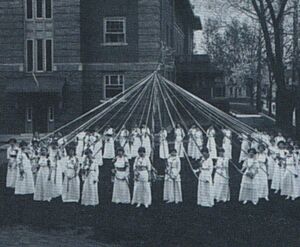
Women were first allowed to enroll as undergraduate students in 1868. Margaret Boyd graduated from Ohio University in 1873, becoming the first woman to earn a degree there. She had asked that her diploma not have masculine endings, and the university changed them for her. President Scott called her the "oldest of a great sisterhood of graduates." Margaret Boyd is still a popular figure on campus, with many things named in her honor.
By 1874, there were fourteen female students, including Minerva Woodson, who was likely the first Black female student at Ohio University. Famous suffragist Susan B. Anthony visited Athens in 1878.
In 1883, Cynthia Weld was hired as the first female faculty member. She taught history and rhetoric. The first known international student, Saki Taro Murayama from Japan, graduated in 1895.
Starting in 1902, the new State Normal College (which later became the College of Education) attracted many women who wanted to become teachers. To house them, the university built Boyd Hall in 1906, named after Margaret Boyd.
However, the university did not provide housing for Martha Jane Hunley (Blackburn), who was the first Black female graduate in 1916. She had to find her own place to live in Athens. In 1999, the university honored her by adding her name, along with John Newton Templeton's, to the Templeton-Blackburn Alumni Memorial Auditorium.
By the 1900s, nearly half of the university's students were female. They formed sororities and clubs like the Home Economics Club and the Young Women's Christian Association (YWCA). In 1913, with about 330 women and 500 men, the university hired its first Dean of Women, Irma Voigt. She quickly worked to create a Women's League to build "spirit, loyalty, and standards" among the female students.
Becoming a Modern University
Ohio University changed from a frontier school to a modern one. While it always offered a liberal arts education, the College of Liberal Arts was officially organized in 1902.
Dean Irma Voigt was very influential for 36 years. She helped create activities for women, including the YWCA and the Women's Recreation Association. When the Nineteenth Amendment gave women the right to vote in 1920, Voigt, who supported women's suffrage, organized political discussions for women. She also made women's rules more flexible and even refereed women's basketball games.
In 1935, Ohio University reorganized its two colleges into five, adding colleges for Commerce, Fine Arts, and Applied Science. The Graduate College was created in 1936, and the first PhD program started in chemistry in 1956. Dean Irma Voigt retired in 1949, and Voigt Hall was named in her honor in 1953.
Starting in the mid-1900s, the university also began to open regional campuses across southeast Ohio. The first, Ohio University – Chillicothe, opened in 1946 to help with overcrowding after World War II. Many of its first students were veterans. Other campuses followed in places like Zanesville, Ironton, Lancaster, and St. Clairsville.
Times of Change and Protest
Growing Bigger
The 1900s saw a huge increase in students, courses, and research facilities. During World War I and World War II, Ohio students and faculty contributed to the war effort. Many service members returned home and enrolled in college. Between 1955 and 1970, the number of undergraduate students tripled from 7,000 to 20,000. During this time, the campus grew a lot, with 25 new dormitories, radio and television stations, and the 13,000-seat Convocation Center arena.
The 1960s: A Time of Big Changes

The 1960s brought many changes to the Athens campus. There was a focus on gender equality, protecting the environment, and equal education for African Americans. In 1963, the university hired its first Black faculty member. Black student organizations met with President Alden to ask for more Black faculty, more African American books in the library, and more programs for Black students.
In 1964, U.S. President Lyndon B. Johnson first spoke about his Great Society plan on the College Green. This brought national and international attention to the university. The 1960s also brought changes for women. In 1967, women were removed from the famous Marching 110 band for seven years. That same year, cafeteria workers (who were all women) went on strike, demanding fair job classifications and better conditions. In 1969, hundreds of women protested the university's curfew policy by staying out past their curfew.
The main library opened in May 1969. It was dedicated as Freedom Library outside and Alden Library inside. Also in 1969, African American Studies was established at Ohio University.
The 1970s: Protests and New Programs
The 1970s were a decade of more change. The Vietnam War was very unpopular with Ohio University students and Athens residents. On May 4, 1970, the Ohio National Guard shot students protesting the war at Kent State University, killing 4 and wounding 9. At the same time, there were sit-ins and anti-war protests at Ohio University, even more intense than at Kent State. This was partly because Ohio University's administration refused to close the school. Many students from other closed Ohio universities came to Athens to protest.
When the Ohio National Guard was called to Athens, there was a 3-hour battle at the Baker Center. This resulted in 23 injuries and 54 arrests. On May 15, the campus was closed.
In 1972, the university stopped having women's hours (curfews). In 1975, Ohio established its medical school, the Heritage College of Osteopathic Medicine. It is the only medical school in Ohio that awards the Doctor of Osteopathic Medicine degree. In 1978, the first women's studies program was organized at the university.
Reaching Out to the World
New Ideas and Growth in the 80s and 90s
Since the 1980s, Ohio University has grown its global impact with new programs, faculty, and students. This period saw the university become a distinctive national university, not just a regional one. By 1980, eighteen women's studies courses were offered. In the early 1980s, for the first time, women students outnumbered men.
The Ohio University Innovation Center, which helps new technology businesses, started in 1983. The Ohio University Edison Biotechnology Institute was founded in 1984. A graduate Women's Studies program was approved in 1985.
The number of female faculty members grew significantly in the 1990s. In 1993, Barbara Ross-Lee, D.O., became the first African American woman to serve as dean of a medical school in America, at the Heritage College of Osteopathic Medicine. Visibility for Queer students also increased on campus in the 1990s.
During the Glidden administration (1994-2004), new buildings were constructed, including the Life Sciences Research Facility and Emeriti Park. Major renovations also took place. In 1995, a plaque was placed on Memorial Auditorium to remember Susan B. Anthony's visit to Athens, celebrating 75 years of women's suffrage.
Recent Years: A Global University
The 2000s, 2010s, and 2020s have seen Ohio University's impact grow rapidly. The university launched the Global Leadership Center to involve students in worldwide projects. By 2004, the university recognized several Distinguished Teaching Professors. Roderick McDavis was elected Ohio University's first Black president, serving for 13 years.
Ohio University has a Women's Center in the Baker University Center. It provides study space, health resources, and programs for women. In 2009, Venki Ramakrishnan, a former Ohio University student, shared the Nobel Prize in Chemistry for his work on the ribosome.
Ohio University became a space-grant institution in the 2010s. In 2012, the university changed its academic calendar from quarters to semesters. The College Green has continued to host speeches from important people.
In January 2022, Ohio University achieved its first national designation as a "R1: Doctoral Universities – Very high research activity" institution. This means it is recognized for its high level of research. In March 2023, Lori Stewart Gonzalez was elected the 23rd and first woman President in Ohio University's 219-year history.
As of 2022, Ohio University has nine campuses, nine undergraduate colleges, its Graduate College, its medical college, and its public affairs school. It offers over 250 areas of study for undergraduate, master's, and doctoral degrees. Ohio University is one of the top 30 largest residential college campuses in the United States.
See also
- History of Ohio
- List of Ohio University alumni
- List of Ohio University faculty


